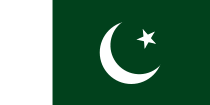Flag of Pakistan
 | |
| Name | Parc̱am-e Sitārah o-Hilāl (Flag of the Crescent and Star) |
|---|---|
| Use | National flag |
| Proportion | 2:3 |
| Adopted | August 11, 1947 |
| Design | A white star and crescent on a dark green field, with a vertical white stripe at the hoist |
| Designed by | Amiruddin Kidwai |
| Part of a series on the |
| Culture of Pakistan |
|---|
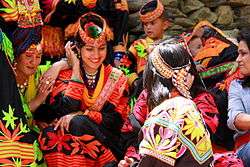 |
| Traditions |
|
Mythology and folklore |
| Cuisine |
|
Music and performing arts |
| Sport |
|
Monuments |
|
The national flag of Pakistan (Urdu: قومی پرچم, Qaumī Pārc̱am) was adopted in its present form during a meeting of the Constituent Assembly on August 11, 1947, just four days before the country's independence, when it became the official flag of the Dominion of Pakistan.[1][2][3] It was afterwards retained by the current-day Islamic Republic of Pakistan. The flag is a green field with a white crescent moon and five-rayed star at its centre, and a vertical white stripe at the hoist side. Though the green colour is mandated only as 'dark green',[4] its official and most consistent representation is Pakistan green, which is shaded distinctively darker. The flag was designed by Amiruddin Kidwai, and is based on the All-India Muslim League flag.[5]
The flag is referred to in the national anthem as the Flag of the Crescent and Star. It is flown on several important days of the year including Republic Day, Independence Day and Defence Day. It is often hoisted every morning at schools, offices and government buildings to the sound of the national anthem and lowered again before sunset. A notable flag raising and lowering ceremony is carried out each day with great pomp and enthusiasm at the Wagah Border attended by hundreds of spectators. A designer named Amiruddin Kidwai studied the League’s flag, as he tried to design a flag for a new, independent nation. Finally he arrived at a design, and he presented it to the leadership of the Muslim League who subsequently adopted his design as the flag of the Dominion of Pakistan on 11 August, 1947. The government of Pakistan has pronounced rules about the flying of the flag. It is to be displayed at full mast on 23 March of each year, marking the adoption of the Lahore Resolution in 1940 and the Declaration of the Republic of Pakistan in 1956, and on 14 August in celebration of Independence Day, when Pakistan was carved out from British India as a home for Indian Muslims.
History and symbolism
Before the Second World War, Muslims and Hindus lived together under the British Raj. A number of the Muslims formed the All India Muslim League. After the Second World War, when the independence of Pakistan in 1947, the flag of the Muslim League served as the basis for the flag of Pakistan.
The green represents Islam and the majority Muslims in Pakistan and the white stripe represents religious minorities and minority religions.[6] In the centre, the crescent and star symbolizes progress and light respectively.[6] The flag symbolizes Pakistan's commitment to Islam and the rights of religious minorities.[7] It is based on the original flag of the Muslim League, which itself drew inspiration from the flag of the Sultanate of Delhi, the flag of Ottoman Empire and the Flag of the Mughal Empire.
Design

The official design of the national flag was adopted by the Constituent Assembly together with a definition of the features and proportions.
According to the specifications it is a dark green rectangular flag in the proportion of length [A] and width [B] as 3:2 with a white vertical bar at the mast, the green portion bearing a white crescent in the centre and a five-pointed white heraldic star. The width of the white portion [C] is one quarter the width of the flag [A], nearest the mast, so the green portion occupies the remaining three quarters [D].
Dimensions
The Interior Ministry of Pakistan provides dimensions for flags in different circumstances:
- For ceremonial occasions: 21′ × 14′, 18′ × 12′, 11′ × 6 2⁄3′ or 9′ × 6 1⁄4′.
- For use over buildings: 6′ × 4′ or 3′ × 2′.
- For cars: 24″ × 16″.
- For tables: 10 1⁄4″ × 8 1⁄4″.
National flag protocols
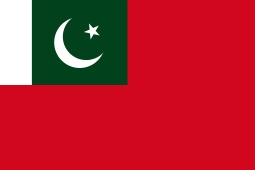 | |
| Use | Civil ensign |
|---|---|
| Proportion | 2:3 |
| Design | A red field with the national flag in the canton. |
|
Variant flag of Pakistan (variants) | |
| Use | Naval ensign |
| Proportion | 1:2 |
| Design | A lengthened version of the national flag. |
- No other flag must fly higher.
- When displayed or flown alongside other national flags, the National Flag must be displayed or flown at the same height as the other national flags, never lower.
- When displayed alongside provincial, military or corporate flags, the National Flag must be higher.
- When tied to a mast, it must be tied only at the left (at the beginning of the white bar) and left to fly freely without any obstruction.
- Must not touch the ground, shoes or feet or anything unclean.
- Must never be flown in darkness.
- Must be raised at dawn and lowered at dusk (except on the Parliament of Pakistan, which is the only official building on which the flag is never lowered). When flown over the Parliament of Pakistan at night, it must always remain alit with artificial light.
- Must not be marked with anything (including words, numerals or images).
- When raising or lowering: (i) must be saluted to by all uniformed personnel, (ii) others must stand in attention.
- Must be raised or lowered ceremoniously.
- When displayed horizontally, the white strip must always be at the left, with green field on the right
- When displayed vertically, the white strip must always be at the top, with green field at the bottom.
- Must not fly or be displayed upside down or with the crescent and star facing left.
- Must not be displayed anywhere where it is likely to get dirty.
- Must not be set on fire or trampled upon.
- Must not be buried or lowered into a grave (when burying a flag-bearing casket, the National Flag must be detached from the casket and held above the grave as the casket is lowered or removed from the casket before burial).
Flag flying days
| Date | Position | Reason[8] |
|---|---|---|
| March 23 | Full-mast | Pakistan Day: Adoption of the Lahore Resolution (1940) and declaration of the Islamic Republic (1956) |
| April 21 | Half-mast | Death Anniversary of the National Poet, Muhammad Iqbal (1938) |
| August 14 | Full-mast | Independence Day (1947) |
| September 11 | Half-mast | Death Anniversary of the Father of the Nation, Muhammad Ali Jinnah (1948) |
| December 25 | Full-mast | Birthday of Muhammad Ali Jinnah (1876) |
Use by public officials
The use of the national flag is regulated by the Pakistan Flag Rules, which were introduced in 2002 by Prime Minister Zafarullah Khan Jamali. The Rules are not available online but there have been instances of misuse such as officials using flags on their vehicles when they are not entitled to do so.[9][10] The national flag is flown on the official residences and vehicles (cars, boats, planes) of the following public officials:[8]
| Office | Flag on Official Residence | Flag on Vehicles |
|---|---|---|
| The President of Pakistan[11] | | |
| The Prime Minister of Pakistan[11] | | |
| The Chairman of the Senate | | |
| The Speaker of the National Assembly | | |
| The Chief Justice of Pakistan | | |
| The Chief Justice of the Federal Shariat Court | | |
| The Governors of the Provinces | | |
| Federal Ministers (and officials entitled to the privileges of Federal Ministers) | | |
| The Chief Ministers of the Provinces | | |
| The Ministers of the Provinces | | |
| The Chief Election Commissioner | | |
| The Deputy Chairman of the Senate | | |
| The Deputy Speaker of the National Assembly | | |
| The Speakers of the Provincial Assemblies | | |
| The Chief Justices of the High Courts | | |
| Ambassadors and High Commissioners of Pakistan | | |
| Commissioners of Divisions, Deputy Commissioners and Political Agents | |
Milestones
- 2014 - On 15 February, 29,040 people gathered in a stadium in Lahore to form the flag of Pakistan and set a new world record for forming the world's largest national flag comprising humans, which was certified by Guinness World Records.[12][13]
- 2012 - On 22 October, 24,200 people gathered in a stadium in Lahore to form the flag of Pakistan and set a new world record for forming the world's largest national flag comprising humans, which was certified by Guinness World Records.[14]
- 2004 - In August, a 340×510 (173,400 square foot) foot flag of Pakistan was unfurled at the National Stadium Karachi, setting the world record for the largest flag.[15][16]
- 1947 - On the night of August 14, 1947, a group of Indian Boy Scouts were in France when the news reached them that their motherland had become independent. Mohammad Iqbal Qureshi was one of the Muslim boy scouts who with the help of his friends turned a green turban into a Pakistani flag and unfurled it. August 15, 1947 was the first time when the Pakistani flag flew on the foreign soil.
Similar flags
 Flag of Turkey
Flag of Turkey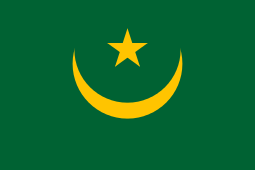 Flag of Mauritania
Flag of Mauritania Flag of Malaysia
Flag of Malaysia Flag of Algeria
Flag of Algeria Flag of Libya
Flag of Libya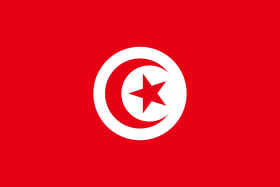 Flag of Tunisia
Flag of Tunisia Flag of Azerbaijan
Flag of Azerbaijan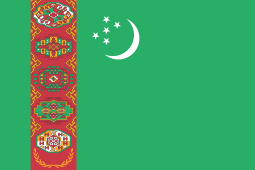 Flag of Turkmenistan
Flag of Turkmenistan Flag of Uzbekistan
Flag of Uzbekistan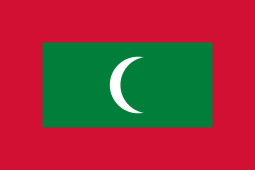 Flag of the Maldives
Flag of the Maldives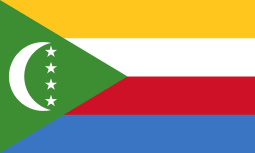 Flag of the Comoros
Flag of the Comoros Flag of Singapore
Flag of Singapore
See also
- List of Pakistani flags
- Flags of the World
- Vexillology
- Coat of arms of Pakistan
- National Anthem of Pakistan
- Flag of the President of Pakistan
References
- ↑ "Pakistan Flag specification: Resolution Passed by Constituent Assembly". Pakistan.org. Retrieved 2007-12-11.
- ↑ "Parliamentary History". National Assembly of Pakistan. Archived from the original on 2007-10-24. Retrieved 2007-12-11.
- ↑ "Parliamentary History of Pakistan" (PDF). Parliamentary Division, Government of Pakistan. Archived from the original (PDF) on 2008-02-16. Retrieved 2007-12-11.
- ↑ "Government of Pakistan: Flag description". Pakistan.gov.pk. Retrieved 2007-12-11.
- ↑ "National Flag and Anthem". Embassy of the Islamic Republic of Pakistan, Tokyo. Retrieved June 29, 2013.
- 1 2 "Pakistan flag". Ministry of Information and Broadcasting, Government of Pakistan. Retrieved 2007-12-11.
- ↑ "Basic Facts". Ministry of Information and Broadcasting, Government of Pakistan. Retrieved 2007-12-11.
- 1 2 "Pakistan Flag". Ministry of the Interior, Government of Pakistan. Archived from the original on 2007-11-14. Retrieved 2007-12-11.
- ↑ "Secs and advisers can't fly flags on cars, homes". Daily Times of Pakistan. 2005-10-21. Retrieved 2007-12-11.
- ↑ "National flag 'not being misused'". Dawn Group of Newspapers. 2005-01-13. Retrieved 2007-12-11.
- 1 2 Note:- The President and the Prime Minister may fly a personal flag in addition to the National Flag.
- ↑ http://www.nation.com.pk/national/15-Feb-2014/pakistan-breaks-world-record-for-largest-human-flag
- ↑ http://epaper.dawn.com/DetailNews.php?StoryText=16_02_2014_003_006
- ↑ "Pakistan sets another record for world's largest flag". Tribune. 22 October 2012. Retrieved 18 December 2013.
|first1=missing|last1=in Authors list (help) - ↑ Flag superlatives
- ↑ YouTube - Worlds Largest Flag
Further reading
- "Pakistani flag hoisted on South American peak". DAWN. 18 December 2013. Retrieved 18 December 2013.
|first1=missing|last1=in Authors list (help)
External links
- "Pakistan Flag". Ministry of the Interior, Government of Pakistan. Archived from the original on 2007-11-14. Retrieved 2007-12-11.
- Pakistan at Flags of the World
